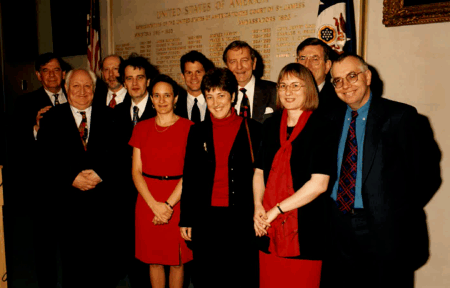How JSTOR evolved: Expanding access and preserving knowledge worldwide
This blog post is part of a series dedicated to celebrating JSTOR’s 30th anniversary. Explore the whole series.
Just a few years after its founding—originally sparked by a library shelf crisis—JSTOR quickly expanded its mission-driven impact beyond the United States and beyond printed journals. This post looks back at the years 1998 to 2016, a period of foundational growth in international outreach and digital preservation that reflects JSTOR’s commitment to broadening access and preserving scholarly content for future generations at scale.
Crossing borders: JSTOR goes global (1998–2001)
In 1998, JSTOR took its first major step onto the international stage by signing an agreement with Jisc in the UK, marking the start of a long-term partnership focused on advancing research and education. A UK-based mirror site was launched, followed by tailored fee models to serve overseas libraries. Foundation grants from organizations like Mellon, Howard Hughes Medical Institute, MacArthur, and Niarchos helped extend access to libraries in regions including Eastern Europe, Greece, South Africa, and the former Soviet Union. JSTOR’s global vision was strategic and mission-driven: to reduce barriers to knowledge wherever they existed in ways that were financially sustainable for participants and for JSTOR.

JSTOR-JISC 25 Year Agreement Signing Event in the UK (1998).
Building digital preservation infrastructure for long-term access
As publication of electronic journals began to grow, JSTOR recognized the next step to enable libraries and publishers to move to digital-only publications and collections—a permanent preservation solution for electronic content. In 2002, the Electronic Archiving Initiative launched with Mellon Foundation support, marking a pivotal moment in JSTOR’s history. This initiative laid the groundwork for Portico, a trusted digital preservation service that would become essential in safeguarding born-digital scholarly content. With this move, JSTOR helped to ensure permanence for the scholarly record and helped to accelerate a global shift in the digital transformation of academic publishing and libraries.
Innovation for sustainable growth
The early 2000s were also marked by ambitious innovation to help support broader digital transformation in academia. In 2004, ITHAKA was founded as a separate nonprofit organization from JSTOR to conduct research and provide strategic guidance (what later became Ithaka S+R) and to be an incubator for nascent mission-aligned services like Aluka (focused on African content), Portico, and NITLE, which supported liberal arts colleges in adopting educational technologies. Establishing ITHAKA greatly expanded capacity to lead change across scholarly communities, while continuing to enable JSTOR to grow and thrive independently. In 2009, ITHAKA merged with JSTOR,unifying three mission-aligned services JSTOR, Portico, and Ithaka S+R under one roof with a common mission to improve access to education and knowledge.
Another trademark service, Artstor, became part of ITHAKA in 2016. This strategic alliance expanded JSTOR’s platform to include high-quality, rights-cleared images used in teaching and research. Artstor’s Shared Shelf product (later JSTOR Forum) allowed institutions to manage and share their own digital collections, enhancing JSTOR’s stewardship services. It was a turning point that underscored JSTOR’s role not just as a provider of resources but as an active partner in digital heritage preservation. Today, following Artstor’s integration to JSTOR in 2024, Artstor on JSTOR continues to be a home of more than 2.5 million images, as well as growing multimedia content. Building on this legacy, JSTOR recently launched JSTOR Digital Stewardship Services, a new initiative designed to help institutions preserve, manage, and share their digital collections with greater ease and sustainability. Developed collaboratively with library professionals, JSTOR Digital Stewardship Services offers expert guidance, hosting infrastructure, and tools tailored to the evolving needs of libraries, archives, and museums—further solidifying JSTOR’s commitment to long-term digital preservation and access.
Lasting impact and looking ahead
These milestones and developments laid the foundation for JSTOR’s continued leadership in open access, digital scholarship, and community-driven innovation. Today, JSTOR serves a global network of libraries and institutions, offering access to more than 96 million pages of content.
Over the past thirty years, the landscape of higher education has changed dramatically—along with the evolving needs and challenges of scholarly communities and libraries. Guided by a user-centered approach, JSTOR remains committed to developing its offerings in close partnership with the academic community, continuing to serve as a trusted ally, even in uncertain times.
Read more about JSTOR’s early years in JSTOR: A History by our very own Roger C. Schonfeld, and stay tuned for more stories diving into our history.
Do you remember your first encounter with JSTOR—as a student, librarian, or curious learner? We’d love to hear your story!
About the author

Rumika Suzuki Hillyer is a Content & Community Engagement Manager at ITHAKA, where she leverages her teaching background and social media skills to connect with a diverse range of JSTOR users. From enrolling in an ESL program at a community college to earning a doctoral degree in sociology, Rumika has developed a comprehensive understanding of various tiers of higher education in the U.S. and their associated challenges. She is excited to embark on her journey with ITHAKA, where she hopes to contribute to its mission and promote accessible and equitable higher education for all.